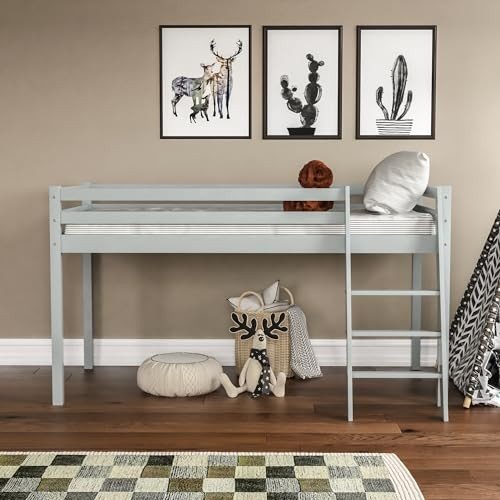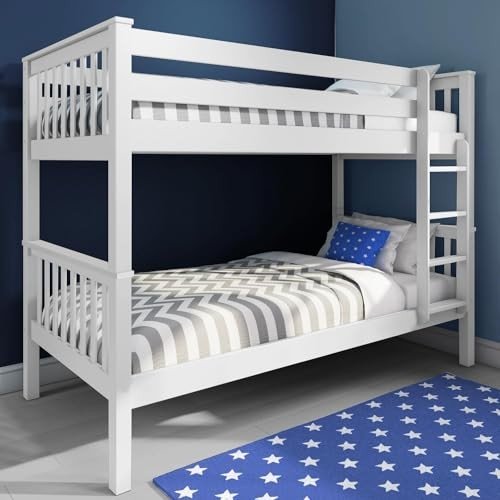10 Things That Your Family Taught You About Childrens Bunk Beds With M…
페이지 정보

본문
 Childrens Bunk Beds With Mattresses Must Be Safe
Childrens Bunk Beds With Mattresses Must Be SafeBunk beds are an excellent way to save space. It's important that bunk beds with ladders or stairs are securely fastened.
The mattress should also be low-profile so that the surface of the bunk bed mattress for children is at least 5 inches below the top rails. Some bunk beds come with trundle options to sleep three easily, which is ideal for sleepovers or for guests to visit.
Size
Bunk beds are popular as spaces-saving solutions for children's room bunk beds bedrooms. By stacking beds vertically, they allow for more floor space to fit other furniture, such as wardrobes and desks. Bunk beds are also great for shared rooms and dormitories because they save valuable space for siblings sharing a single room.
When choosing a childrens metal bunk beds bed for your child, take into consideration their age and ability to safely climb up onto the top of the bed. Bunk beds aren't recommended until children reach the age of six. Even then, you should follow the safety guidelines laid out by the manufacturer. These include sturdy guardrails and a ladder with a stable base, as well as providing enough clearance for height to the ceiling.
Another factor to consider is the size of the mattress on the bunk bed. Bunk beds are available in twin or full size, and they must fit snugly within the frame of the bunk. Gaps can cause an entrapment, which can compromise the stability. Choose a mattress that has an innerspring, hybrid memory foam or hybrid construction for your child to ensure comfort and support.
To comply with safety guidelines for children, bunk bed mattresses must also be 8-14 inches thick. A mattress that is too thin could cause the top bunk to collapse or roll away, which is risky for children. It is also beneficial to select a bunk bed with a built-in ladder for easier access to the top sleeping area.
Height
Bunk beds are a popular choice for kids' rooms because they can be used to store extra items and free up the floor space. However, before buying a bed, it is important to consider the dimensions of the bunk bed, as this could affect the safety and comfort of the mattress. For instance, bunk beds must meet British safety standards. The rails of the bed must be at least 16 cm higher than the mattress in order to keep children from falling off.
When you are deciding on a bunk bed, it's also worth considering the ceiling's height, like lights and fans since they could affect the overall size of the bed. Also, consider whether you intend to use a ladder or stairs to access the top bunk as these should be sturdy and strong or secured to stop them from moving and posing a risk.
For the mattress, it's best to choose a low profile option, as this will increase the height of the rails of safety on the top bunk. This is crucial as the heavier the mattress is, the higher its height will be, which could hinder your child's vision and make it harder to get out of bed.
It is also important to consider whether you will be using twin or full size mattresses for your bunk bed. If you want to maximize space, a twin-over-full arrangement is the best choice. It gives each child a bed and still allow plenty of space to store things. If you're planning to use a King mattress in the lower tier, then you should consider frames that are designed specifically for this kind of arrangement as they will be more stable and secure than the standard bunk beds.
Weight
Bunk beds with mattresses are a great solution for families with children sharing the same room. They help maximise space by fitting two beds into the same space, and also allowing additional storage with built-in storage drawers or cubbies.
When you are choosing a bunk bed that has mattresses, make sure you adhere to the strictest safety standards. It's important to choose a bunk bed with mattresses that meet strict safety standards. The bunk bed's slats should also have ample spacing to prevent entrapment risks.
If your children are sharing the top bunk bed, you should be aware of the capacity of the bed and make sure that it is able to accommodate each without exceeding the limit. This is essential to avoid structural problems or weaknesses that could compromise the safety and stability.
While it's tempting for kids jump on their bunk bed (or even climb up the ladder during time of play) but remember that they're still not yet able to develop the sense of security that will guide their actions on a surface that is elevated. Most children over the age of 6 have the physical and cognitive capacity to be able to sleep on the top bunk beds childrens in a safe manner; however, it's up to you as a parent to decide whether your child is prepared for this sleep arrangement.
Choose a mattress comprised of all-foam for a bunk bed with mattress to limit noise disturbances during the night. You should consider a mattress that features cooling technology to keep the bunk mattress cool and comfortable particularly during summer nights that are hot and humid.
Cooling
small childrens bunk beds beds are a beautiful and space-saving option, but you cannot simply walk into a store to pick up the first mattress you see. Kids bunk beds require special features to ensure a the safety of a sound and safe sleep, especially for children who sleep on the top childrens mid sleeper bunk beds. They should be thin enough to meet federal fire safety standards, yet thick enough to keep children from falling off the top bunk. They should also be light and low-profile to fit into the frame.
When buying a bunk mattress You should take into consideration its thickness and the material it is made from. A good rule of thumb is to choose a mattress that is about 6 inches thick. This will ensure that your child's mattress does not rise above the safety railing on the top bunk and that they are unable to roll out without being caught. The thickness of the mattress on a bunk bed is also important, since it will determine the amount of space your child will have on the top bunk.
When you are choosing the mattress for your bunk bed, it is important to be aware of whether it is soft or firm. A mattress that is soft will be more comfortable, but the firmer mattress will provide more support for the spine of your child's. You should also think about the amount of storage space the mattress offers. A bunk bed with storage will allow you to keep your child's bedroom clean and organized. It could even aid in making them more productive at school.
Safety
To prevent injuries and accidents, bunk beds with mattresses must be constructed in the same way like other children's furniture. The first step is to examine the stability of the bed by looking at every single structure point like the corners where the feet and the bed base are joined to the frame. Make sure that all of them are securely fastened, and that there is not any movement or instability.
It is also important to make sure that the mattress's foundations are strong enough to withstand your child's weight and the weight of their sibling who will be sleeping on top. You can test this by placing pressure on the mattress from different angles to see whether it flexes or moves. If it does, this is not a good sign and you should replace the mattress foundation.
Once the bunk bed is put in place, you need to take steps to ensure that the space surrounding the bed is free of any hazards for tripping. This means making sure that any furniture that's not required for the bunk is removed out of the room. You should also prohibit the play of rough and jumping around in the bunks. Make it clear that one child is allowed to sleep on the top bed.
 It's also a good idea to get your kids into the habit of removing toys from the area surrounding their bed on a daily basis. This will help to avoid accidents due to suffocation and tripping that could occur when kids are climbing up and down from the bunks. It's important that you emphasize that these rules must be observed regardless of whether guests are coming over for the night.
It's also a good idea to get your kids into the habit of removing toys from the area surrounding their bed on a daily basis. This will help to avoid accidents due to suffocation and tripping that could occur when kids are climbing up and down from the bunks. It's important that you emphasize that these rules must be observed regardless of whether guests are coming over for the night.- 이전글The 10 Most Terrifying Things About Wheelchair Ramps For Homes 24.12.08
- 다음글Three Common Reasons Your Nissan Qashqai Replacement Key Isn't Working (And What You Can Do To Fix It) 24.12.08
댓글목록
등록된 댓글이 없습니다.




